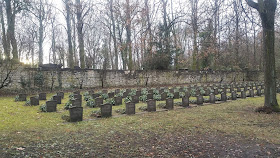 |
| Berlin, Germany. Der verlassene Raum (The Deserted Room). Karl Biedermann, sculptor. Photo: Samuel D. Gruber 2016 |
 |
| Berlin, Germany. Der verlassene Raum (The Deserted Room). Karl Biedermann, sculptor. Photo: Samuel D. Gruber 2016 |
by Samuel D. Gruber
Berlin is a city of monuments and memorials, celebrating Prussian power and now, in recent decades, Nazi crimes. The list of Holocaust commemorative sites, plaques, statues, exhibitions in continually growing. This is to say nothing of the more than 5,000 stolpersteine that have now been installed on pavements throughout the city, with many in the Berlin-Mitte neighborhood. Having so many commemorative sites allows for great variety. Some are explicit and narrative; some conceptual and abstract. Some are generic and some precise. Some are collective, while some remember specific individuals and families. But even when taken together all these monuments cannot convey the enormity of suffering and loss; of astonishment, fear, violence, pain, and death.
 |
| Berlin, Germany. Examples of Stolpersteine commemorating former Jewish residents of Grosse Hambrger Str. 30. Photo: Sameul Gruber 2016 |
Examples are in Sopron, Hungary, where a 2004 monument by László Kutas is cast from real clothes to suggest the garments left by victims in the "showers" of Auschwitz. In Budapest, the 2005 memorial on the banks of the Danube of cast shoes and boots - to signify the victims who were shot and thrown into the icy river in 1944-45 by Arrow Cross militiamen - is another powerful example. These Hungarian examples are more specific in the references than The Deserted Room which could equally have been installed in Paris, Amsterdam, Brussels or any other occupied cavity from which Jews where Jews rounded up and deported. But it also speaks to any place today where refugees must run from their homes, never to return.
 |
| Sopron, Hungary. Memorial to the Victims of the Holocaust from Sopron, László Kutas, sculptor, 2004. Photo: szoborlap.hu |
 |
| Budapest, Hungary. Danube River Monument,
2005. Gyula
Pauer,
artist. Photo: Samuel Gruber 2009 |
 |
| Berlin, Germany. Der verlassene Raum (The Deserted Room). Karl Biedermann, sculptor. Photo: Samuel D. Gruber 2016 |
O die Wohnungen des Todes,
Einladend hergerichtet
Für den Wirt des Hauses, der sonst Gast war –
O ihr Finger,
Die Eingangsschwelle legend
Wie ein Messer zwischen Leben und Tod –
O ihr Schornsteine,
O ihr Finger,
Und Israels Leib im Rauch durch die Luft!
[O dwellings of death
Set out so enticingly
For the host of the house, who used to be the guest –
Set out so enticingly
For the host of the house, who used to be the guest –
O you fingers
Laying the stone of the threshold
Like a knife between life and death –
O you chimneys
O you fingers
And Israel’s body dissolves in smoke through the air!]
Laying the stone of the threshold
Like a knife between life and death –
O you chimneys
O you fingers
And Israel’s body dissolves in smoke through the air!]
 |
| Berlin, Germany. Der verlassene Raum (The Deserted Room). Karl Biedermann, sculptor. Photo: Samuel D. Gruber 2016 |
 | |
| Berlin, Germany. Der verlassene Raum (The Deserted Room). Karl Biedermann, sculptor. Photo: Samuel D. Gruber 2016 |
I'll be adding more about the Berlin Commemorative landscape in coming weeks.



































